目录
一,3120. 统计特殊字母的数量 I
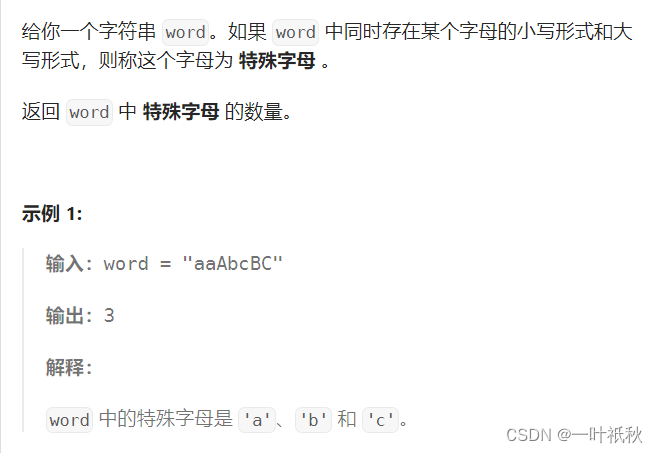
本题就是统计有多少个字母的大小写同时出现在字符串word中,分别使用一个数组来统计大写字母和小写字母的出现次数。
代码如下:
class Solution {
public int numberOfSpecialChars(String word) {
int[] cnt1 = new int[26];//大写
int[] cnt2 = new int[26];//小写
for(char ch : word.toCharArray()){
if(Character.isUpperCase(ch)){
cnt1[ch-'A']++;
}else{
cnt2[ch-'a']++;
}
}
int ans = 0;
for(int i=0; i<26; i++){
if(cnt1[i]>0 && cnt2[i]>0)
ans++;
}
return ans;
}
}二,3121. 统计特殊字母的数量 II
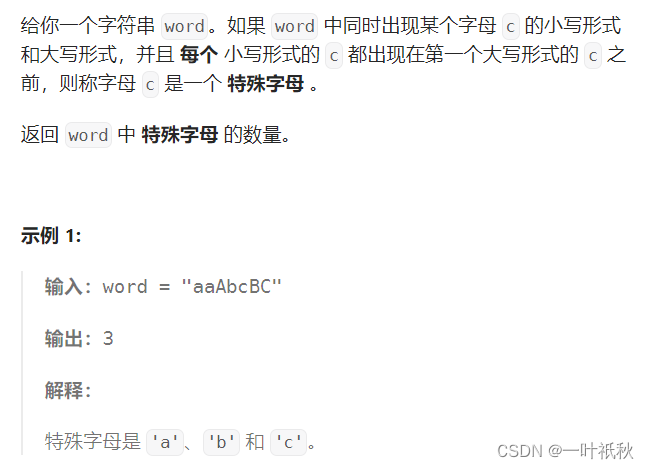
本题比上一题多了一些条件,不仅要大小写都出现,并且所有的小写字母都要出现在其对应大写字母的前面。所以可以使用两个数组分别存储,一个存储大写字母的第一次出现下标,另一个存储小写字母最后一次出现下标,如果大小写都出现&小写字母的下标<大写字母的下标,那么就+1。
代码如下:
class Solution {
public int numberOfSpecialChars(String word) {
int[] idx1 = new int[26];//大写字母第一次出现的下标
int[] idx2 = new int[26];//小写字母最后一次出现的下标
Arrays.fill(idx1, -1);
Arrays.fill(idx2, -1);
char[] ch = word.toCharArray();
for(int i=0; i<ch.length; i++){
if(Character.isLowerCase(ch[i])){
idx2[ch[i]-'a'] = i;
}else{
idx1[ch[i]-'A'] = idx1[ch[i]-'A']==-1?i:idx1[ch[i]-'A'];
}
}
int ans = 0;
for(int i=0; i<26; i++){
if(idx1[i]!=-1&&idx2[i]!=-1&&idx1[i]>idx2[i])
ans++;
}
return ans;
}
}上述做法更加不容易出错,但是还有更加省时间的做法,可以一次遍历实现,使用一个hash表来统计出现的大小写字母,再使用一个数组 cnt 来统计 26 个字母的状态:
- 0:该字母没有计入答案
- 1:该字母已计入答案
- 2:该字母不可能是答案
遍历该字符串:
- 如果是大写字母,并且之前出现过小写字母,将cnt[i] = 0 (表示该字母没有被计入ans中),将cnt[i] = 1,ans++
- 如果是小写字母,并且之前出现过大写字母&& cnt[i] == 1 (表示该字母已经被计入ans中),将cnt[i] = 2 (表示该字母不可能是答案),ans--
- 如果是大写字母,并且之前没有出现过小写字母,将cnt[i]=2 (表示该字母不可能是答案),防止出现BbB这种情况
class Solution {
public int numberOfSpecialChars(String word) {
Set<Character> set = new HashSet<>();//统计大小写
int[] cnt = new int[26];
//0:该字母没有计入答案
//1:该字母已计入答案
//2:该字母被计入答案后又出现小写字母,又被删除
int ans = 0;
for(char ch : word.toCharArray()){
if(Character.isUpperCase(ch)){
//小写字母出现后大写字母出现的情况
if(set.contains(Character.toLowerCase(ch)) && cnt[ch-'A']==0){
cnt[ch-'A'] = 1;
ans++;
}
//出现小写字母未出现,先出现大写字母的情况!!!(容易忽略)
if(!set.contains(Character.toLowerCase(ch))){
cnt[ch-'A'] = 2;
}
}else{
//出现大写字母后,又出现小写字母的情况
if(set.contains(Character.toUpperCase(ch)) && cnt[ch-'a']==1){
cnt[ch-'a'] = 2;
ans--;
}
}
set.add(ch);
}
return ans;
}
}三,3122. 使矩阵满足条件的最少操作次数
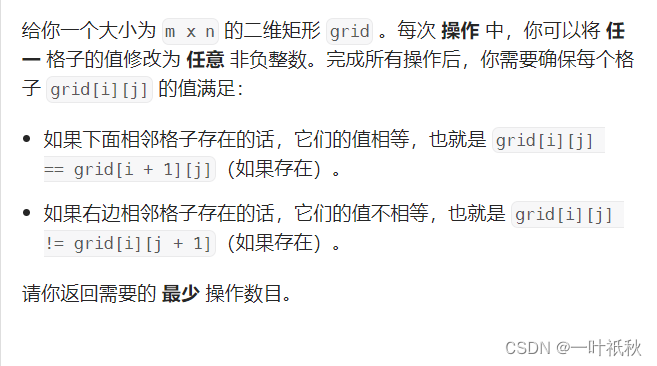
没有思路,先考虑暴力求解,也就是枚举每一列选择保留的数字,保证相邻两列保留的数不一样,求保留的最大值,所以 dfs 就需要两个变量,一个存储当前的列数,一个存储上一个保留的数字。
dfs(i,pre) 的定义:前 i 列数可以保留的最大数目。
- 结束条件:i < 0,返回 0
- 每次递归要做:使用 j 遍历0~9,res = Math.max( res,dfs(i-1,j)+cnt[ i ][ j ]),cnt[ i ][ j ]表示当前列中有多少个 j
- 结果: res
class Solution {
Map<String, Integer> map = new HashMap<>();
public int minimumOperations(int[][] grid) {
int n = grid.length;
int m = grid[0].length;
int[][] cnt = new int[m][10];
for(int i=0; i<n; i++){
for(int j=0; j<m; j++){
cnt[j][grid[i][j]]++;
}
}
return n*m - dfs(m-1, cnt, -1);
}
int dfs(int i, int[][] cnt, int pre){
String key = i + "-" + pre;
if(!map.isEmpty() && map.containsKey(key))
return map.get(key);
if(i < 0) return 0;
int res = 0;
for(int j=0; j<=9; j++){
if(j != pre)
res = Math.max(res, dfs(i-1, cnt, j)+cnt[i][j]);
}
map.put(key, res);
return res;
}
}四,3123. 最短路径中的边
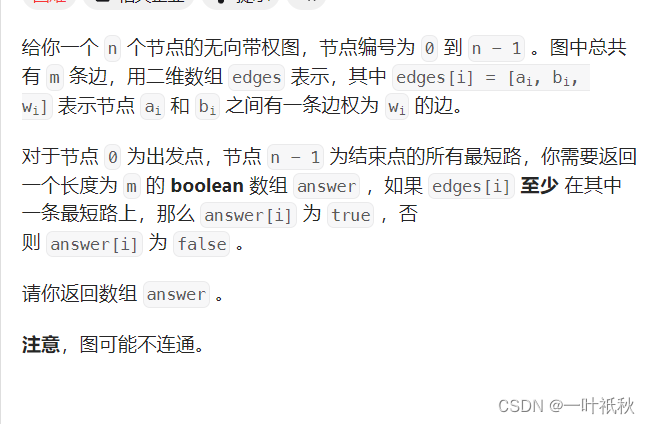
本题和上周双周赛一样,考的还是djstra算法,只不过它问的是edges[i]是否在0->n-1节点的最短路径上,这里有两种做法,先讲简单一点的:
使用两次djstra算法,分别算出从0到所有位置的最短路径dis1,以及从n-1到所有位置的最短路径dis2,再遍历edges数组(x=e[0],y=e[1],w=e[2]),判断 dis1[x] + dis2[y] + w == dis1[n-1] 或者 dis1[y] + dis2[x] + w == dis1[n-1],如果相等说明ans[i] = true,否则 ans[i] = false。就是下图两种情况:
代码如下:
class Solution {
int n;
public boolean[] findAnswer(int n, int[][] edges) {
this.n = n;
List<int[]>[] g = new ArrayList[n];
Arrays.setAll(g, e->new ArrayList<>());
for(int i=0; i<edges.length; i++){
int[] e = edges[i];
int x = e[0], y = e[1], w = e[2];
g[x].add(new int[]{y, w});
g[y].add(new int[]{x, w});
}
int[] dis1 = dis(g, 0);//0->?的最短路径
int[] dis2 = dis(g, n-1);//n-1 -> ?的最短路径
int mn = dis1[n-1];
boolean[] ans = new boolean[edges.length];
for(int i=0; i<edges.length; i++){
int[] e = edges[i];
int x = e[0], y = e[1], w = e[2];
if(dis1[x] + dis2[y] + w == mn || dis1[y]+dis2[x]+w==mn){
ans[i] = true;
}else{
ans[i] = false;
}
}
return ans;
}
int[] dis(List<int[]>[] g, int s){
int[] dis = new int[n];
Arrays.fill(dis, Integer.MAX_VALUE/2);
dis[s] = 0;
PriorityQueue<int[]> que = new PriorityQueue<>((x,y)->x[0]-y[0]);
que.offer(new int[]{0, s});
while(!que.isEmpty()){
int[] t = que.poll();
int dx = t[0];
int x = t[1];
if(dx > dis[x]){
continue;
}
for(int[] y : g[x]){
int idx = y[0];
int newDis = dx + y[1];
if(dis[idx]==Integer.MAX_VALUE/2 || newDis < dis[idx]){
dis[idx] = newDis;
que.offer(new int[]{newDis,idx});
}
}
}
return dis;
}
}另一种解法和上述解法的思路是相同的,但是时间复杂度更低,只使用一次djstra算法,算出从0到所有位置的最短路径dis,然后从n-1出发,倒着dfs,如果dis[y] + w == dis[x],就说明当前x-y这段路径在最短路径上。
代码如下:
class Solution {
public boolean[] findAnswer(int n, int[][] edges) {
List<int[]>[] g = new ArrayList[n];
Arrays.setAll(g, e->new ArrayList<>());
for(int i=0; i<edges.length; i++){
int[] e = edges[i];
int x = e[0], y = e[1], w = e[2];
g[x].add(new int[]{y, w, i});
g[y].add(new int[]{x, w, i});
}
PriorityQueue<int[]> que = new PriorityQueue<>((x,y)->x[0]-y[0]);
que.offer(new int[]{0, 0});
int[] dis = new int[n];
Arrays.fill(dis, Integer.MAX_VALUE/2);
dis[0] = 0;
while(!que.isEmpty()){
int[] t = que.poll();
int dx = t[0];
int x = t[1];
if(dx > dis[x]) continue;
for(int[] y : g[x]){
int idx = y[0];
int newDis = dx + y[1];
if(dis[idx]==Integer.MAX_VALUE/2 || newDis < dis[idx]){
dis[idx] = newDis;
que.offer(new int[]{newDis, idx});
}
}
}
boolean[] ans = new boolean[edges.length];
if(dis[n-1] == Integer.MAX_VALUE/2) return ans;
boolean[] vis = new boolean[n];
dfs(n-1, dis, ans, vis, g);
return ans;
}
void dfs(int x, int[] dis, boolean[] ans, boolean[] vis, List<int[]>[] g){
vis[x] = true;
for(int[] t : g[x]){
int y = t[0], w = t[1], i = t[2];
if(dis[y] + w != dis[x])
continue;
ans[i] = true;
if(!vis[y]){
dfs(y, dis, ans, vis, g);
}
}
}
}







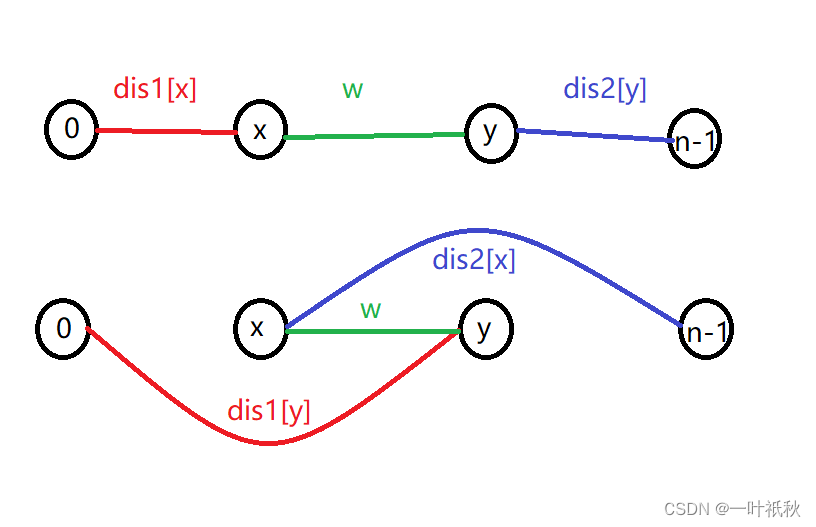















 265
265











 被折叠的 条评论
为什么被折叠?
被折叠的 条评论
为什么被折叠?










